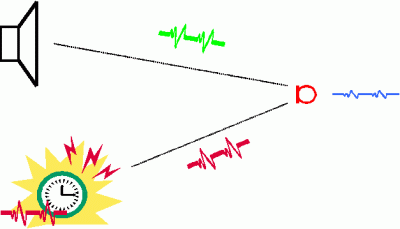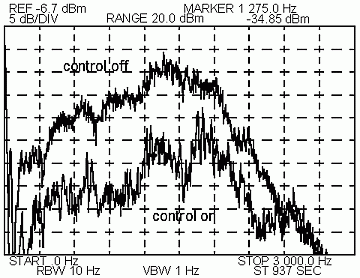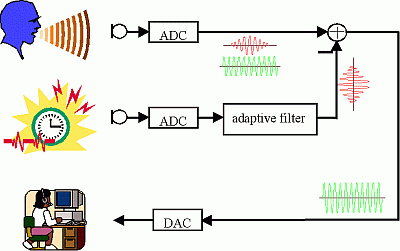|
Dept. of Measurement and Information Systems, Budapest University of Technology and Economics Digital Signal Processing Laboratory
|
|
Active Noise Control
Introduction
Passive suppression of low-frequency noise or vibration has numerous disadvantages, mainly because of the volume of the absorbers. By the usage of signal processors it has became possible to utilize different active noise control methods. These are based on the phenomenon of the destructive interference. A "secondary" noise has to be generated, which suppresses the "primary" (i.e. the original) noise at the properly situated microphones. Signals of the microphones are used to control the secondary noise.
Fig. 1. The basic idea of active noise control
The whole problem has acoustical, signal processing and control aspects. In some cases, if the secondary source can be installed near to the primary source (e.g. a ventilation duct), a single loudspeaker-microphone pair is enough. In other cases, if the noise source is not concentrated, and the suppression in an enclosure has to be achieved (e.g. an airplane), more loudspeakers and microphones are utilized.
Active noise control is a new research and development direction at our department. However, the knowledge-base in measurement, system identification and signal processing helps us to obtain new results in this field. The performance of the noise control system is usually evaluated by the spectra of the microphone signals measured with and without control. Typical spectra can be seen in the figure below.
Fig. 2. The effect of active noise control on the spectrum of the noise
Technical Background
Active noise control requires multifarious knowledge in the field of measurement, analog and digital signal processing and acoustics. Design of active noise control systems needs measurements on the plant to be controlled. The records derived during the measurements play an essential role in plant identification and system simulation. Algorithm design and evaluation has a central role. It should be in close ties with the other parts of the design process. The main task is to implement or improve digital signal processing methods which can be used for this purpose. Although the design needs the first measurement results, involving the a priori knowledge in the field (literature, experiences) the development can be started at the beginning of the design. This development work includes theoretical derivations, simulations and laboratory experiments. Due to the special features (e.g. high temperature) of the possible acoustic systems, the active noise control system needs special hardware tools. Sensor and actuator design is an important part of the system design. The final phase requires industrial experiments giving feedback to the above parts of the design. This experimental phase is also for revealing the scope of active noise control for the actual purpose.
Research Activities
Conventional noise controllers are usually adaptive filters, with the parameters updated mainly on LMS basis. The first systems for this task were feedback systems. The most successful applications of them are single channel systems in which the loudspeaker is closely positioned to the error microphone (e.g. an ear defender). The next step was the implementation of feedforward controllers. These systems need an additional reference signal which is correlated with the primary noise. Feedforward control was successfully implemented in various active noise systems. Such adaptive systems utilize the filtered-X LMS (XLMS) algorithm, therefore they need a built-in model on the acoustic path between the secondary source and the microphone. The accuracy of this model influences the success of the control. Inaccurate model leads to loss in the performance, or in serious cases the system will be unstable. Adaptive systems are able to suppress both broadband and harmonic noise.
Periodic noise control
If the noise to be suppressed is periodic, adaptive feedforward control is straightforward, because of the easily available reference signal. This control task is rather simple, therefore the controller should be simple, as well. However, the structure of the usual adaptive controllers is similar to that for broadband noise control. The aim of our first research work was to design an adequate controller, which is fitted to periodic noise cancelation providing simpler structure and better control results than the conventional adaptive controllers.
The theoretical background of such a controller design is the adaptive Fourier analysis. The adaptive Fourier analyzer (AFA) is a structurally adaptive system for exact measurement of band-limited periodic signals of arbitrary fundamental frequency. It is an extension of the resonator based observers developed earlier to perform the recursive discrete Fourier transform (RDFT). In these observers the resonators work in a common feedback loop providing zero steady-state feedback error at the resonator frequencies. The AFA adapts the resonator frequencies to coincide with those in the input signal. The proposed noise controller can be considered as an extension of the AFA. The block diagram of the system can be seen in the following figure.
Fig. 3. Periodic noise control
More details can be found in the paper presented at the Active'97 conference.
Broadband Noise Control
The experience with periodic noise controller design helped us to extend the ideas to the field of broadband noise control. In the scope of the research was the convergence of the LMS based adaptive filter structure.
Adaptive filters updated by the least mean square (LMS) algorithm are successfully utilized for both identification and control purposes in active noise control systems. In the case of noise control, the output of the adaptive filter drives the secondary loudspeaker, and the error signal is derived by the microphone only at the end of the secondary path. In such cases the filtered reference LMS (XLMS) algorithm guarantees the stable adaptation. Multiple channel systems utilize the multiple error LMS algorithm. However, the convergence of these algorithms can be very slow, depending on the transfer function of the secondary path. We have introduced a novel algorithm which provides much higher convergence rate than the XLMS algorithm. The proposed structure is a modification of the XLMS structure: in addition to the filter in the reference signal path, a secondary filter is applied, and the same filter is applied in the error signal path. This secondary filter is designed so that the resulted magnitude response in the adaptation loop oscillates around the unity. The proposed algorithm was extended also for multiple channel active noise control. Numerical and practical examples verify that the proposed method improves the convergence rate significantly without high additional computational demand. The block diagram can be seen in the next figure.
Fig. 4. Broadband noise control with the application of the extended XLMS algorithm
More details can be found in the paper presented at the Active'99 conference. On-line Identification of the Secondary Path
The transfer function of the secondary path can change considerably that the built-in model cannot ensure the stability of the system. In this case the system is unstable, it should be turned off, and the identification should be carried out again. In certain applications such a change is quite common, so the off-line identification is not a proper solution for active noise control. Such applications are the outdoor noise control tasks, where the change of the temperature or the humidity of the air causes meaningful change in the secondary path. Another possibility is the sudden change in rooms (e.g. door opening).
The research of this topic has just recently started, with the application of the adaptive filter based methods available in the literature. The resonator-based controller developed for periodic noise control could be improved so that it is able to retain its stability even if the secondary path changes.
Application of Sensor NetworksNowadays sensor networks are used more frequently for data acquisition. It is a straightforward idea that the signal of the microphones can be pre-processed and transmitted by the elements of the networks (these are the so-called motes). The great advantage of the solution is that the installation of the microphones is much simpler, and the geometry of the system is easily reconfigurable. The block diagram of our first system can be seen in the following figure.
Fig. 5. Active noise control with sensor network
One of the motes has not microphone, it has a wired connection to a DSP board, where the algorithm is implemented. The loudspeakers are connected also by wires.
Applications
Active noise control poses many theoretical problems, the research results can be used by other engineers working in this field. On the other hand the implementation has an essential role. The development of certain applications answers whether a new algorithm is really viable.
|
|
|
|
Active Noise Control for Furnaces
The aim is development of active control systems which suppress the noise appearing in furnaces and boiler rooms. The noise generated by the combustion chamber of the furnace has different injurious influences: in extreme situations it can destroy the equipment, but even at normal conditions the noise is harmful for the personnel working in the boiler room. The noise leaving the boiler room is a heavy environmental load. Conventional methods of suppressing this noise using sound absorbers generally do not work well at such circumstances. On the one hand, the power of this noise is concentrated in the low-frequency range (below 500 Hz), on the other hand traditional noise absorbers cannot be installed on furnaces. Active cancelation of the furnace-noise seems to be a promising solution. This project was granted by the Hungarian Fund for Scientific Research OTKA T-023868.
Noise Control of Transformers
The noise of high-power (in the range of 1 megawatts) transformers causes high environmental load, especially at night. The noise radiation cannot be reduced properly by the design of the transformers, this is why active noise control is a real alternative. The task is a nice example of outdoor noise control, where the noise radiation should be reduced in a certain direction. Since the noise to be suppressed is periodic, the resonator-based controller has been suggested.
Other Applications
The principle of active noise control can be applied not only for vibroacoustic problems. It has other physical content, but very similar problems are to be solved if active magnetic shielding is to be produced. Our experimental system works well. The theoretical connection is more complicated but also a similar approach can be used if a high-voltage or high-current sine wave generator is to be designed. Usual electronic devices generate a distorted waveform, and the undesired higher harmonics can be canceled actively.
Recommended publications:
|
S. M. Kuo, D. R. Morgan, "Active noise control: a tutorial review", Proceedings of the IEEE, vol. 87, No. 6, June, 1999, pp. 943-973. |
Review of the research field. The most important algorithms and applications are investigated, and more than 150 references cited. |
|
L. Sujbert, G. Péceli, "Noise cancelation using resonator based controller", presented on the Active '97 - The International EAA Symposium on Active Control of Sound and Vibration, Aug. 21-23, 1997, Budapest, Hungary, in proceedings pages 905-916. |
Introduction of the resonator-based controller, developed at the DSP laboratory. |
|
L. Sujbert, "A new filtered LMS algorithm for active noise control", presented on the Active '99 - The International EAA Symposium on Active Control of Sound and Vibration, Dec. 2-4, 1999, Fort Lauderdale, Florida, USA, in proceedings pages 1101-1110. |
Improvement of the classical XLMS algorithm. |
|
L. Sujbert, B. Vargha, "Active distortion cancelation of sinusoidal sources", presented on the IEEE Instrumentation and Measurement Technology Conference, May. 18-20, 2004, Como, Italy, in proceedings pages 322-326. |
Application of the theoretical results in a different field. |
Other related publications of the DSP laboratory can be found on this page.
Useful Links:
|
Acoustic applications of signal processing, from physical basics to modern algortithms. The "isvr" (University of Southampton, Institute of Sound and Vibration Research) is one of the most known research center of the topic. | |
|
Introduction to active noise control, from the basics to interesting real applications. |
Further information: László Sujbert








